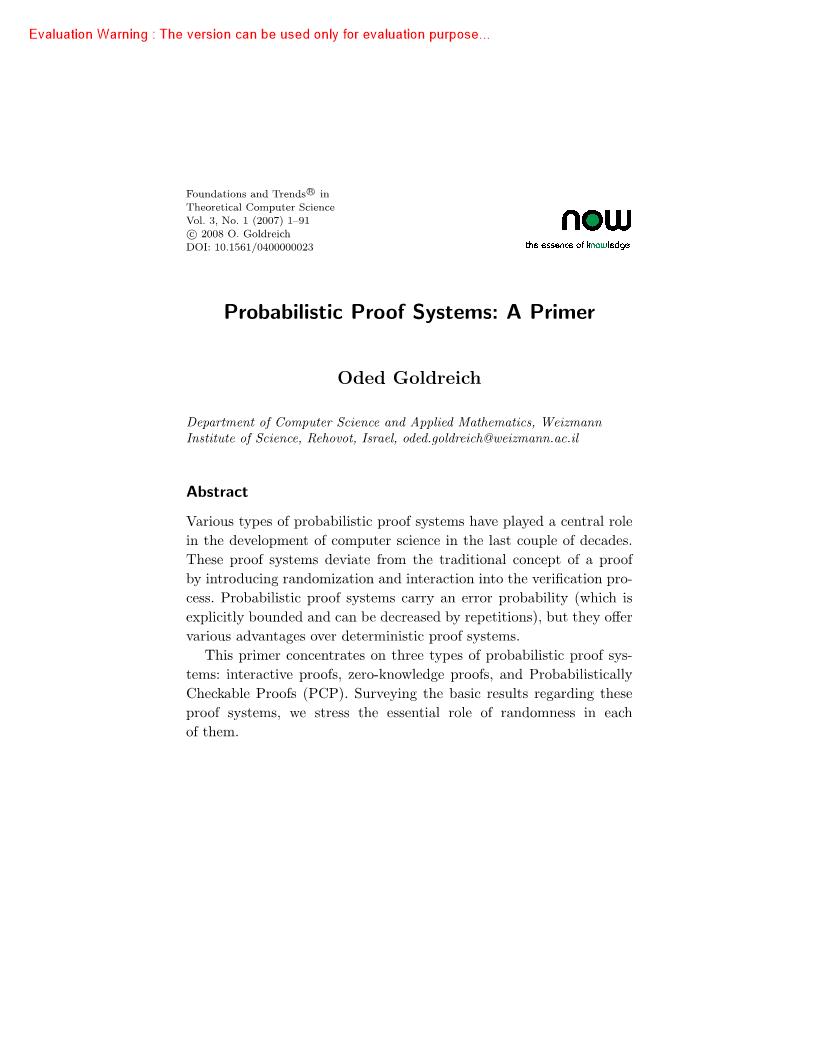《Probabilistic Proof Systems A Primer_Oded Goldreich》pdf电子书免费下载
下载方式一:
百度网盘下载地址:https://pan.baidu.com/s/1q8kd8ZF7F_2c17jAMeEUEA
百度网盘密码:1111
下载方式二:
http://ziliaoshare.cn/Download/af_124135_pd_ProbabilisticProofSystemsAPrimer_OdedGoldreich.zip
|
|
作者:empty 页数:91 出版社:empty |
《Probabilistic Proof Systems A Primer_Oded Goldreich》介绍
Various types of probabilistic proof syste tns have played a central rolein the development of computer science in the last couple of decadesThese proof systems deviate from the traditional concept of a proofby introducing randomization and interaction into the verification pro-cess.Probabilistic proof systems carry an error probability(which isexplicitly hounded and can be decreased by repetitions) , but they offervarious advantages over deterministic proof systemsThis primer concentrates on three types of probab listic proof sys-tems:interactive proofs, zero-knowledge proofs, and ProbabilisticallyCheckable Proofs(PCP) Surveying the basic results regarding theseproofs yate ms, we stress the essential role of randomness in eachof them.
Most results surveyed in this text hold unc oui ditionally However, theseresults are only interesting if NP+P.One Important Con u ention.When presenting a proof system, we stateall complexity bounds in terms of the length of the assertion to beproved(which is viewed as an input to the verifier) .Namn ely, when wesay“polynomial-time”weine an time that is polynomial in the lengthof this assertion.Indeed, as will become evident, this is the naturalchoice in all the cases that we consider.Note that this convention isconsistent with the definition of NP-proof system ns.Notational Conventions.We denote by poly these to fall integer func-tions that are upper-hounded by a polynomial, and by log the set ofall integer functions bounded by a logarithmic function(i.e., fe logif and only iff(n) =O(logn) ) .All complexity in ea sires mentioned inthis section are assumed to be constr act ible in polynomial-time.Organization.In Section 1, we present the basic definitions and resultsregarding interactive proof systems.The definition of an interactiveproof system is the starting point for a discussion of zero-knowledgeproofs, which is provided in Section 2.Section 3, which presents the
1.1 Motivation and Perspective 5and/or accompany these interpretations.This discussion is aimed atemphasizing that the motivation for the de inition of interactive proofsystem nsis not replacing the notion of a in a the matical proof, but rathercapturing other forms of proofs that are of natural interest.Specifically,we shall contrast written proofs with“interactive proofs, highlightthe roles of the“prover”and the“verifier”in any proof, and discussthe notions of completeness and soundness which in der lie any proof(Some readers may find it useful to return to this section after readingSection 1.2.)
1.1.1A Static Object Vs.an Interactive ProcessTraditionally in mathematics.a proof is a fired sequence consistingof statements that are either self-evident or are derived from previ-ous statements via self-evident rules.Actually, both conceptually andtechnically, it is more accurate to substitute the phrase“self-evident”by the phrase“commonly agreed upon”(because, at the last accountself-evidence is a matter of common agreement) .In fact, in the formalstudy of proofs(i.e., logic) .the commonly agreed statements are calleda rioms, whereas the commonly agre od rules are refer rod to as deriva-tion rules.We highlight a key property of mathematical proofs:theseproofs are f ized(static) objects.In contrast, in other areas of human activity, the notion of a proofhas a much wider interpretation.In particular.in many settings.a proofis not a fixed object but rather a process by which the validity of anassertion is established.For example, in the context of law, withstand-ing across-examination by an opponent, who may ask tough and/ortricky questions, is considered a proof of the facts claimed by the wit-ness.Likewise, various debates that take place in daily life have an anal-ogo us potential of establishing claims and are then perceived as proofsThis perception is quite common in philosophical and political debates,and applies even in scientific debates.Needless to say, a key properly ofsuch debates is their inter uct iue(“dynamic ) nature.Int crcs tingly, theappealing nature of such-interactive proofs is refi ected in the fact thatthey are mimicked(in a rigorous manner} in some mathematical proofs
